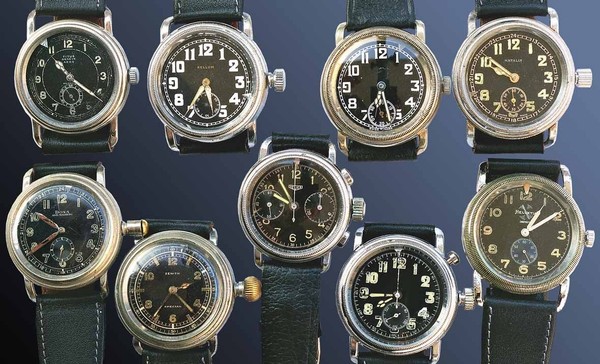Military Timepieces -- 150 Years Watches and Clocks of German Forces
"Military Timepieces" is a magnificent book, and it is worthy of a comprehensive review. At this time, however, I believe that it is more important to provide this brief description of the book, so that our readers will be aware of this fantastic resource (which appears to have gone almost unnoticed here in the United States). This book will be valuable to anyone who is interested in vintage timepieces, generally, and chronographs and timers, in particular. Of particular interest to our readers, there is also significant content about Heuers in both these categories -- chronographs and timers.
Let's begin with the subject matter -- Military Timepieces catalogs the watches, chronographs, clocks, timers and stopwatches that were used by the German military over the period from 1850 through recent years. The range of brands covered the the book is surprising. I had expected to see the major German brands -- Junghans, Tutima, Glashutte, Lange & Soehne, Wempe, etc. It never occured to me that I would find interesting models from Heuer and Leonidas, along with Omega, Longines, Minerva, Zenith, IWC, Rolex, Panerai and dozens of other Swiss brands. If it was a timepiece that was used by the German armies over the last 150 years -- whether in a cockpit, on a flight deck, in a submarine, by special naval forces, or in any other function -- then it is presented in Military Timepieces.
With the subject matter being so broad and the timeframe spanning so many years, one might expect that the coverage of any particular timepiece is rather cursory. Maybe a couple of nice photographs and a few captions?? This is the next wonderous surprise about Military Timepieces -- the images and information presented about each of the timepieces covered are comprehensive. For each timepiece, Knirim generally presents a photograph of the dial, the movement and the case (typically to show the military markings), along with identification of the reference number, movement and certain production information. The following page, presenting Lange navigation watches utilized by the Luftwaffe, is typical of Knirim's approach throughout the book.
To catalog, photograph and describe 150 years of timepieces in this fashion would itself be a wonderous creation. Knirim goes far beyond this presentation, however. Along with thousands of photographs of the timepieces, most of them taken by the author himslef, Miitary Timepieces presents additonal materials that either place the timepieces in their proper context or provide additional detailed information. We see not only the Flieger Chronographs, but the pilots who wore them (sorted by era and military unit); we see the bomb timers, and the aircraft in which they were used; we see the field watches, not only in detailed photographs, but also in the field. In short, we see the timepieces in their original settings, with archival photographs and related images.
As an example, the following plate not only shows a Lemania Flieger chronograph; it also shows us the pilots who wore this chronograph, the aircraft that they used, and the airfield that was the base of their operations (the Luftwaffe Testing Site, in Rechlin).
But wait, the wonder of Knirim's book don't stop there. In addition to all the timepieces, and all the images and all the ephemera, Military Timepieces also presents narrative text that tells us about the timepieces, their development and their uses. We learn the differences between particular brands and moels; why specific types of timepieces were selected for specific uses; how the companies that produced the timepieces related to each other; etc. Knirim is not a watchmaker, and technical details of the movements and mechanisms is sparse, rather he is a collector of watches and -- in his words -- a "collector of information".
The most well-known Heuer timepiece associated with military uses was the chronograph designed for the Bundeswehr and introduced by Heuer in 1968. Knirim provides a detailed history of this chronograph, along with his customary ancillary images and ephemera. The following plates show a portion of this presentation.
Long before the creation of the Bundeswehr chronograph, Heuer produced chronographs that were especially designed for pilots. As shown in the photograph below, these chronographs used the same case and dial design as other pilots watches of the period. This photograph shows ten pilots watches from the 1930's; interestingly, the Heuer is the only chronograph included in the group ---
|









